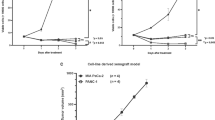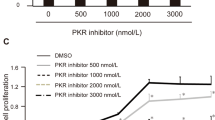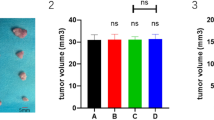Abstract
NK4 or adenovirus vector expressing NK4 (Ad-NK4) can act bifunctionally as a hepatocyte growth factor antagonist and angiogenesis inhibitor and has potential value in cancer therapy. The aim of this study was to evaluate the therapeutic efficacy of Ad-NK4 in combination with gemcitabine (GEM) against pancreatic cancer. In vitro study showed a strong antiproliferative effect of GEM and a potent anti-invasive effect of Ad-NK4 against pancreatic cancer cells. In in vivo experiments, SUIT-2 human pancreatic cancer cells were implanted into the pancreas of nude mice. Mice were treated with Ad-NK4 by injection into the peritumoral region of the pancreas on day 5 after implantation followed by weekly i.p. injections of GEM. On day 28 after implantation, pancreatic tumor volume was significantly smaller than that in mice treated with Ad-LacZ, Ad-NK4 alone, or GEM alone. Furthermore, combination therapy completely suppressed peritoneal dissemination and liver metastases, leading to significantly increased survival. Histologic and immunohistochemical assays of primary tumors indicated that combination therapy prohibited both cell proliferation and angiogenesis, resulting in high levels of apoptosis. These results suggest that peritumoral injection of Ad-NK4 plus GEM is a potent combination therapy for pancreatic cancer.
This is a preview of subscription content, access via your institution
Access options
Subscribe to this journal
Receive 12 print issues and online access
$259.00 per year
only $21.58 per issue
Buy this article
- Purchase on Springer Link
- Instant access to full article PDF
Prices may be subject to local taxes which are calculated during checkout






Similar content being viewed by others
References
FFCR. Cancer Statistics in Japan 2003.
Niederhuber JE, Brennan MF, Menck HR . The National Cancer Data Base report on pancreatic cancer. Cancer 1995; 76: 1671–1677.
Burris III HA, Moore MJ, Andersen J, Green MR, Rothenberg ML, Modiano MR et al. Improvements in survival and clinical benefit with gemcitabine as first-line therapy for patients with advanced pancreas cancer: a randomized trial. J Clin Oncol 1997; 15: 2403–2413.
Nakamura T, Nawa K, Ichihara A . Partial purification and characterization of hepatocyte growth factor from serum of hepatectomized rats. Biochem Biophys Res Commun 1984; 122: 1450–1459.
Nakamura T, Nishizawa T, Hagiya M, Seki T, Shimonishi M, Sugimura A et al. Molecular cloning and expression of human hepatocyte growth factor. Nature 1989; 342: 440–443.
Date K, Matsumoto K, Kuba K, Shimura H, Tanaka M, Nakamura T . Inhibition of tumor growth and invasion by a four-kringle antagonist (HGF/NK4) for hepatocyte growth factor. Oncogene 1998; 17: 3045–3054.
Maehara N, Matsumoto K, Kuba K, Mizumoto K, Tanaka M, Nakamura T . NK4, a four-kringle antagonist of HGF, inhibits spreading and invasion of human pancreatic cancer cells. Br J Cancer 2001; 84: 864–873.
Tomioka D, Maehara N, Kuba K, Mizumoto K, Tanaka M, Matsumoto K et al. Inhibition of growth, invasion, and metastasis of human pancreatic carcinoma cells by NK4 in an orthotopic mouse model. Cancer Res 2001; 61: 7518–7524.
Nakamura T, Matsumoto K, Kiritoshi A, Tano Y . Induction of hepatocyte growth factor in fibroblasts by tumor-derived factors affects invasive growth of tumor cells: in vitro analysis of tumor–stromal interactions. Cancer Res 1997; 57: 3305–3313.
Seslar SP, Nakamura T, Byers SW . Regulation of fibroblast hepatocyte growth factor/scatter factor expression by human breast carcinoma cell lines and peptide growth factors. Cancer Res 1993; 53: 1233–1238.
Di Renzo MF, Poulsom R, Olivero M, Comoglio PM, Lemoine NR . Expression of the Met/hepatocyte growth factor receptor in human pancreatic cancer. Cancer Res 1995; 55: 1129–1138.
Kiehne K, Herzig KH, Folsch UR . c-met expression in pancreatic cancer and effects of hepatocyte growth factor on pancreatic cancer cell growth. Pancreas 1997; 15: 35–40.
Qian LW, Mizumoto K, Inadome N, Nagai E, Sato N, Matsumoto K et al. Radiation stimulates HGF receptor/c-Met expression that leads to amplifying cellular response to HGF stimulation via upregulated receptor tyrosine phosphorylation and MAP kinase activity in pancreatic cancer cells. Int J Cancer 2003; 104: 542–549.
Ohuchida K, Mizumoto K, Murakami M, Qian LW, Sato N, Nagai E et al. Radiation to stromal fibroblasts increases invasiveness of pancreatic cancer cells through tumor–stromal interactions. Cancer Res 2004; 64: 3215–3222.
Ebert M, Yokoyama M, Friess H, Buchler MW, Korc M . Coexpression of the c-met proto-oncogene and hepatocyte growth factor in human pancreatic cancer. Cancer Res 1994; 54: 5775–5778.
Furukawa T, Duguid WP, Kobari M, Matsuno S, Tsao MS . Hepatocyte growth factor and Met receptor expression in human pancreatic carcinogenesis. Am J Pathol 1995; 147: 889–895.
Date K, Matsumoto K, Shimura H, Tanaka M, Nakamura T . HGF/NK4 is a specific antagonist for pleiotrophic actions of hepatocyte growth factor. FEBS Lett 1997; 420: 1–6.
Matsumoto K, Kataoka H, Date K, Nakamura T . Cooperative interaction between alpha- and beta-chains of hepatocyte growth factor on c-Met receptor confers ligand-induced receptor tyrosine phosphorylation and multiple biological responses. J Biol Chem 1998; 273: 22913–22920.
Kuba K, Matsumoto K, Date K, Shimura H, Tanaka M, Nakamura T . HGF/NK4, a four-kringle antagonist of hepatocyte growth factor, is an angiogenesis inhibitor that suppresses tumor growth and metastasis in mice. Cancer Res 2000; 60: 6737–6743.
Maemondo M, Narumi K, Saijo Y, Usui K, Tahara M, Tazawa R et al. Targeting angiogenesis and HGF function using an adenoviral vector expressing the HGF antagonist NK4 for cancer therapy. Mol Ther 2002; 5: 177–185.
McGrory WJ, Bautista DS, Graham FL . A simple technique for the rescue of early region I mutations into infectious human adenovirus type 5. Virology 1988; 163: 614–617.
Korst RJ, Bewig B, Crystal RG . In vitro and in vivo transfer and expression of human surfactant SP-A- and SP-B-associated protein cDNAs mediated by replication-deficient, recombinant adenoviral vectors. Hum Gene Ther 1995; 6: 277–287.
Zhang L, Mizumoto K, Sato N, Ogawa T, Kusumoto M, Niiyama H et al. Quantitative determination of apoptotic death in cultured human pancreatic cancer cells by propidium iodide and digitonin. Cancer Lett 1999; 142: 129–137.
Maehara N, Nagai E, Mizumoto K, Sato N, Matsumoto K, Nakamura T et al. Gene transduction of NK4, HGF antagonist, inhibits in vitro invasion and in vivo growth of human pancreatic cancer. Clin Exp Metastasis 2002; 19: 417–426.
Saimura M, Nagai E, Mizumoto K, Maehara N, Okino H, Katano M et al. Intraperitoneal injection of adenovirus-mediated NK4 gene suppresses peritoneal dissemination of pancreatic cancer cell line AsPC-1 in nude mice. Cancer Gene Ther 2002; 9: 799–806.
Murakami M, Nagai E, Mizumoto K, Saimura M, Ohuchida K, Inadome N et al. Suppression of metastasis of human pancreatic cancer to the liver by transportal injection of recombinant adenoviral NK4 in nude mice. Int J Cancer 2005; 117: 160–165.
Saimura M, Nagai E, Mizumoto K, Maehara N, Minamishima YA, Katano M et al. Tumor suppression through angiogenesis inhibition by SUIT-2 pancreatic cancer cells genetically engineered to secrete NK4. Clin Cancer Res 2002; 8: 3243–3249.
Woodhouse EC, Chuaqui RF, Liotta LA . General mechanisms of metastasis. Cancer 1997; 80: 1529–1537.
Kuba K, Matsumoto K, Ohnishi K, Shiratsuchi T, Tanaka M, Nakamura T . Kringle 1–4 of hepatocyte growth factor inhibits proliferation and migration of human microvascular endothelial cells. Biochem Biophys Res Commun 2000; 279: 846–852.
Jacobs AD . Gemcitabine-based therapy in pancreas cancer: gemcitabine-docetaxel and other novel combinations. Cancer 2002; 95: 923–927.
Ryan DP, Kulke MH, Fuchs CS, Grossbard ML, Grossman SR, Morgan JA et al. A Phase II study of gemcitabine and docetaxel in patients with metastatic pancreatic carcinoma. Cancer 2002; 94: 97–103.
Berlin JD, Catalano P, Thomas JP, Kugler JW, Haller DG, Benson III AB . Phase III study of gemcitabine in combination with fluorouracil versus gemcitabine alone in patients with advanced pancreatic carcinoma: Eastern Cooperative Oncology Group Trial E2297. J Clin Oncol 2002; 20: 3270–3275.
Philip PA, Zalupski MM, Vaitkevicius VK, Arlauskas P, Chaplen R, Heilbrun LK et al. Phase II study of gemcitabine and cisplatin in the treatment of patients with advanced pancreatic carcinoma. Cancer 2001; 92: 569–577.
Colucci G, Giuliani F, Gebbia V, Biglietto M, Rabitti P, Uomo G et al. Gemcitabine alone or with cisplatin for the treatment of patients with locally advanced and/or metastatic pancreatic carcinoma: a prospective, randomized phase III study of the Gruppo Oncologia dell'Italia Meridionale. Cancer 2002; 94: 902–910.
Rocha Lima CM, Savarese D, Bruckner H, Dudek A, Eckardt J, Hainsworth J et al. Irinotecan plus gemcitabine induces both radiographic and CA 19-9 tumor marker responses in patients with previously untreated advanced pancreatic cancer. J Clin Oncol 2002; 20: 1182–1191.
Hecht JR, Bedford R, Abbruzzese JL, Lahoti S, Reid TR, Soetikno RM et al. A phase I/II trial of intratumoral endoscopic ultrasound injection of ONYX-015 with intravenous gemcitabine in unresectable pancreatic carcinoma. Clin Cancer Res 2003; 9: 555–561.
Sangro B, Mazzolini G, Ruiz J, Herraiz M, Quiroga J, Herrero I et al. Phase I trial of intratumoral injection of an adenovirus encoding interleukin-12 for advanced digestive tumors. J Clin Oncol 2004; 22: 1389–1397.
Author information
Authors and Affiliations
Corresponding author
Rights and permissions
About this article
Cite this article
Ogura, Y., Mizumoto, K., Nagai, E. et al. Peritumoral injection of adenovirus vector expressing NK4 combined with gemcitabine treatment suppresses growth and metastasis of human pancreatic cancer cells implanted orthotopically in nude mice and prolongs survival. Cancer Gene Ther 13, 520–529 (2006). https://doi.org/10.1038/sj.cgt.7700921
Received:
Revised:
Accepted:
Published:
Issue Date:
DOI: https://doi.org/10.1038/sj.cgt.7700921
Keywords
This article is cited by
-
Gemcitabine synergistically enhances the effect of adenovirus gene therapy through activation of the CMV promoter in pancreatic cancer cells
Cancer Gene Therapy (2010)
-
Pancreatic cancer: molecular pathogenesis and new therapeutic targets
Nature Reviews Gastroenterology & Hepatology (2009)



